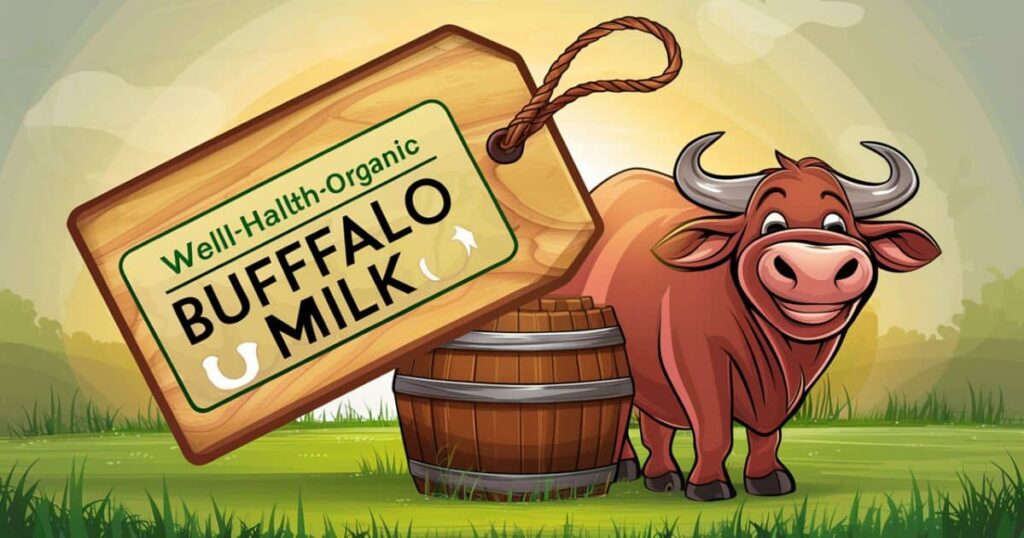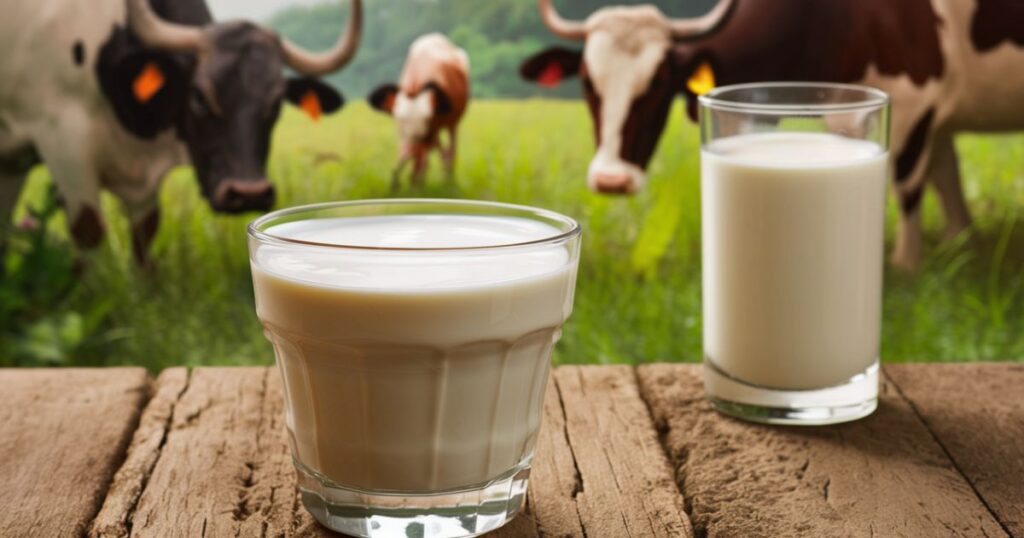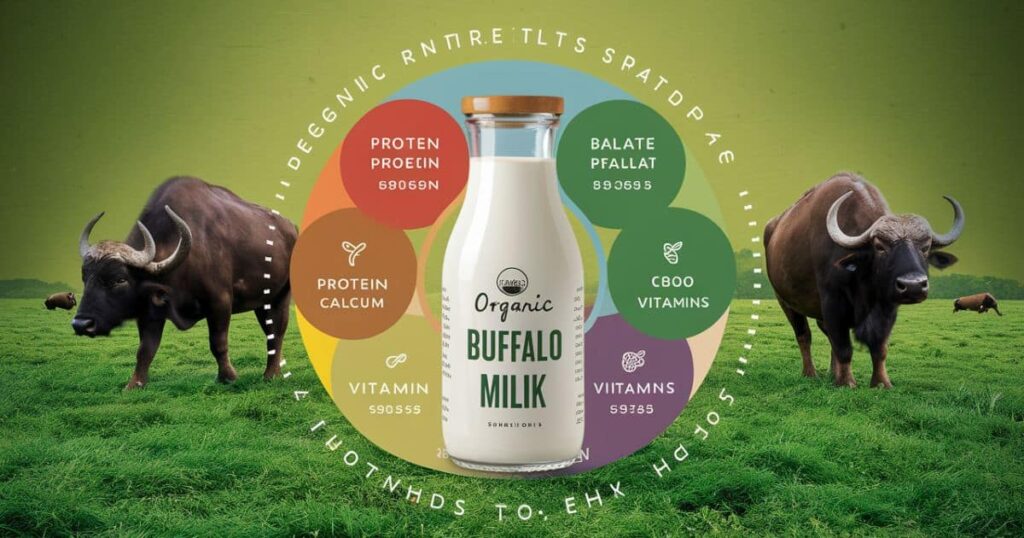WellHealthOrganic Buffalo Milk: A Nutritional Powerhouse
Introduction WellHealthOrganic Buffalo Milk

Buffalo milk, a hidden gem cradled in nature’s embrace, has rightfully claimed its spot in the limelight for its exceptional nutritional merit and potential health-boosting prowess.
While cow’s milk has reigned supreme in many households for ages, buffalo milk offers a unique and nutrient-dense alternative rapidly captivating the hearts and palates of health-conscious consumers worldwide.
This velvety, rich-tasting elixir is lovingly derived from the gentle water buffalo – a species intricately woven into the tapestry of various cultures and culinary traditions across centuries. Originally a treasured native of the Indian subcontinent, buffalo milk is now celebrated and produced in regions spanning Asia, Europe, and even parts of the Americas.
As the awareness of its myriad advantages continues to spread, WellHealthOrganic buffalo milk emerges as a true superfood, promising to revolutionize the way we perceive and embrace dairy products.
Nourishing Organization of Buffalo Milk
Buffalo milk is a genuine force to be reckoned with of required supplements, outperforming the nourishing profile of its all the more normally eaten inverse number, cow’s milk. Here is a more critical glance at its noteworthy piece:
- Protein: Buffalo milk flaunts a higher protein content, going from 3.5% to 4.5%, contrasted with roughly 3.3% in cow’s milk. These proteins are of high organic worth, containing every one of the nine fundamental amino acids important for human wellbeing.
- Fat: With a higher fat substance of around 7% to 12%, bison milk is more extravagant and creamier than cow’s milk, which ordinarily contains 3.5% to 4.5% fat. Notwithstanding, the unsaturated fat piece of bison milk is better, with a higher extent of solid unsaturated fats.
- Calcium and Minerals: Buffalo milk is an excellent source of calcium, providing approximately 200-300 mg per cup, higher than the 120 mg found in cow’s milk. It is also rich in other essential minerals like phosphorus, magnesium, and zinc, which play crucial roles in various bodily functions.
- Vitamins: This nutrient-dense milk is packed with vitamins A, E, B12, and various antioxidants, including carotenoids and tocopherols, which contribute to its creamy color and potential health-promoting properties.
| Nutrient | Buffalo Milk (per 100g) | Cow’s Milk (per 100g) |
| Protein | 4.5g | 3.3g |
| Fat | 8g | 3.7g |
| Calcium | 210mg | 120mg |
| Phosphorus | 107mg | 93mg |
| Vitamin A | 200mcg | 49mcg |
| Vitamin B12 | 0.8mcg | 0.4mcg |
Source: USDA National Nutrient Database
With its impressive nutrient profile, buffalo milk stands out as a superior choice for those seeking a nutritious and indulgent dairy option.
Potential Health Benefits of WellHealthOrganic Buffalo Milk
Strong Bones and Teeth
- High calcium and phosphorus strengthen skeletal structure and support dental health.
- Minerals are essential for developing and maintaining bones and reducing risks of osteoporosis and tooth decay.
Boosted Immunity
- Contains more immunoglobulins and antimicrobials than cow’s milk.
- Natural defenses may strengthen the immune system and protect against illness.
Improved Heart Health
- Unique fatty acid profile includes unsaturated fats and antioxidants.
- Compounds like CLA are linked to lowering cholesterol, reducing inflammation, and decreasing heart disease risk.
Rich Protein Source
- High-quality protein provides all essential amino acids for muscle needs.
- Makes it excellent for athletes, bodybuilders, and those wanting extra protein for growth, repair, and maintenance.
Potential Alternatives for Milk Allergies
For those with cow’s milk allergic reactions or sensitivities, buffalo milk may additionally offer a viable and nutritious alternative. Its hypoallergenic houses stem from the awesome molecular structure of its proteins, that could probably lessen the hazard of hypersensitive reactions in a few people.
whilst not a guarantee, buffalo milk has been efficiently incorporated into the diets of some individuals who can not tolerate cow’s milk, providing them with a treasured source of dairy-based nutrients.
Disadvantages of Buffalo Milk
Despite its severa benefits, it’s essential to renowned a few capacity drawbacks of buffalo milk:
- better fats and cholesterol content material: The better fat content in buffalo milk translates to a better calorie matter and cholesterol level as compared to cow’s milk. this may be a challenge for people with particular nutritional regulations or accelerated levels of cholesterol.
- Lactose Intolerance: Like cow’s milk, buffalo milk incorporates lactose, a natural sugar that can purpose digestive problems for those with lactose intolerance. but, some humans may additionally tolerate buffalo milk better due to its distinctive protein composition.
- constrained Availability and value: Buffalo milk and its merchandise are less extensively to be had and may be greater luxurious than their cow’s milk counterparts, specifically in positive regions wherein buffalo farming isn’t always as widespread.
Precautions and Considerations
whilst buffalo milk is generally secure for intake, it’s essential to workout moderation and seek advice from a healthcare expert, in particular for individuals with specific health conditions or dietary restrictions. proper storage and dealing with suggestions should additionally be followed to make sure food protection.
moreover, some people may additionally enjoy lactose intolerance or allergies to buffalo milk, much like cow’s milk. it’s continually beneficial to introduce new meals steadily and screen for any negative reactions.
Cultural and Culinary Significance
Buffalo milk has played a vast function in diverse cultural and culinary traditions throughout different regions of the sector. In India, Pakistan, and components of the middle East, buffalo milk has been a staple ingredient in numerous dishes and dairy merchandise for hundreds of years.
traditional cuisine like paneer (a clean cheese), ghee (clarified butter), and lassi (a yogurt-based totally drink) are commonly made from buffalo milk, celebrated for their wealthy flavors and particular textures.
beyond its culinary packages, buffalo milk holds deep cultural importance in certain communities, in which the water buffalo is revered as a sacred animal and an necessary part of agricultural practices.
Global Production and Consumption
At the same time as India and Pakistan are the main producers of buffalo milk globally, its production and intake are gradually increasing in different areas as well. nations like Italy, Egypt, and Brazil are a few of the top manufacturers out of doors of the Indian subcontinent.
As focus of its dietary fee and ability fitness blessings grows, the call for for buffalo milk and its products is rising global. This has led to the established order of sustainable buffalo farming practices and the development of specialised dairy industries catering to this area of interest market.
Buffalo Milk vs. Cow’s Milk: Which is Better?

while comparing buffalo milk to cow’s milk, it is vital to consider man or woman dietary wishes and choices. here is a breakdown of a few key factors:
- Dietary Profile: Buffalo milk is commonly better in protein, fats, calcium, and sure vitamins and minerals, making it a more nutrient-dense alternative.
- Taste and Texture: Buffalo milk has a richer, creamier flavor and thicker texture as compared to cow’s milk, which a few purchasers may decide on.
- Digestibility: whilst both comprise lactose, a few people may additionally find buffalo milk simpler to digest due to its precise protein composition.
- Environmental impact: Buffalo farming is regularly considered greater sustainable and environmentally friendly than huge-scale cow farming operations, as water buffaloes have a smaller carbon footprint and require fewer assets.
in the long run, the selection among buffalo milk and cow’s milk depends on private options, nutritional requirements, and accessibility. For those searching for a nutrient-rich dairy choice with capability fitness benefits, buffalo milk can be an brilliant alternative well worth exploring.
Read Also: “Aiotechnical.com Health & Beauty“
Incorporating Buffalo Milk into Your Diet
Incorporating WellHealthOrganic buffalo milk into your food regimen can be a scrumptious and nutritious undertaking. right here are some simple approaches to revel in this superfood:
- Drink it directly: relish the wealthy, creamy taste of buffalo milk by means of ingesting it chilled or warm, simple or flavored with natural sweeteners like honey or vanilla.
- Use it in Cooking and Baking: substitute buffalo milk for cow’s milk in recipes for a lift of taste and vitamins. it really works incredibly nicely in dishes like puddings, soups, and baked items.
- Make Yogurt or Cheese: Buffalo milk may be used to create thick, creamy yogurt or artisanal cheeses like mozzarella, ricotta, and paneer.
Sustainability and Environmental Impact
With people become more aware of how their food choices affect the environment, the production of buffalo milk is a viable and sustainable substitute for conventional dairy farming methods.
When compared to cattle, water buffaloes are recognized for their economical use of resources and reduced greenhouse gas emissions. They may survive on marginal sites unsuited for other agricultural activities, use less water, and emit less methane.
likewise buffalo ranching frequently helps family-run and small-scale businesses, giving rural populations a vital source of income and empowerment. This can support biodiversity in nearby habitats and aid in preserving of traditional farming methods.
Customers who choose WellHealthOrganic buffalo milk and its products support a more environmentally conscious and sustainable food system in addition to reaping the nutritional benefits.
Research and Studies
Although traditional traditions have long acknowledged the potential health advantages of buffalo milk, modern research is now more focused on examining and validating its special qualities. Here are a few noteworthy discoveries:
- Compared to cow’s milk, buffalo milk showed stronger antioxidant activity and had higher amounts of advantageous components including conjugated linoleic acid (CLA), according to a study published in the Journal of Dairy Science (Talpur et al., 2008).
- Buffalo milk may help improve lipid profiles and lower the risk of cardiovascular disease, according to research from the National Dairy Research Institute in India (Kumar et al., 2016).
The journal Comprehensive Reviews in Food Science and Food Safety released a review article that emphasized buffalo milk’s potential as a functional food because
Addressing Common Misconceptions
Notwithstanding its developing reputation, there are nonetheless a few not unusual misconceptions and issues surrounding buffalo milk that want to be addressed:
- fable: Buffalo Milk is hard to Digest: while it’s proper that buffalo milk incorporates higher stages of fats and protein compared to cow’s milk, many people discover it easier to digest due to its unique protein composition and lower ranges of certain allergenic components.
- problem: excessive fat and cholesterol content: even as buffalo milk does have a better fats and cholesterol content, the form of fats it carries (like unsaturated fatty acids and CLA) may also definitely be beneficial for coronary heart health. Moderation and portion manipulate are still important, as with every excessive-fat meals.
- myth: Buffalo Milk is most effective for particular Cultures: whilst buffalo milk has deep cultural roots in certain regions, its dietary cost and ability health advantages make it a valuable addition to any weight loss plan, regardless of cultural history.
- subject: constrained Availability and value: while buffalo milk and its merchandise may be less extensively to be had and greater costly in a few regions, their reputation is increasing, main to greater accessibility and more inexpensive alternatives as call for grows.
by way of addressing these misconceptions and providing correct records from dependable assets, customers can make knowledgeable selections approximately incorporating WellHealthOrganic buffalo milk into their existence.
Consumer Awareness and Education
As the demand for buffalo milk continues to rise, there is a growing need for consumer awareness and education to promote its benefits and ensure responsible production and consumption practices.
Organizations, health professionals, and industry leaders can play a crucial role in disseminating accurate information about the nutritional value, potential health benefits, and sustainable production methods of buffalo milk.
Initiatives such as educational campaigns, cooking demonstrations, and community outreach programs can help increase accessibility and promote the integration of buffalo milk into diverse dietary patterns and culinary traditions.
By empowering consumers with knowledge and fostering a deeper appreciation for this nutrient-rich superfood, we can collectively contribute to a more sustainable and health-conscious food system.
Nutritional Value of WellHealthOrganic Buffalo Milk

Buffalo milk is renowned for its exceptional nutritional profile, surpassing the nutritional value of cow’s milk in several aspects. Here’s a detailed breakdown of its macro and micronutrient composition:
Macronutrients:
- Protein: Buffalo milk contains approximately 4.5% protein, which is higher than the 3.3% found in cow’s milk. These proteins are of high biological value, providing all nine essential amino acids necessary for human health.
- Fat: With a fat content ranging from 7% to 12%, buffalo milk is richer and creamier than cow’s milk, which typically contains 3.5% to 4.5% fat. However, the fatty acid composition of buffalo milk is more favorable, with a higher proportion of heart-healthy unsaturated fats like conjugated linoleic acid (CLA).
- Carbohydrates: Buffalo milk contains around 4.8% lactose, a natural sugar found in milk. While similar to the lactose content in cow’s milk, some individuals may find buffalo milk easier to digest due to its unique protein composition.
Micronutrients:
- Calcium: Buffalo milk is an excellent source of calcium, providing approximately 200-300 mg per cup, significantly higher than the 120 mg found in cow’s milk. Calcium is essential for strong bones, teeth, and muscle function.
- Phosphorus: With 107 mg of phosphorus per 100g, buffalo milk offers a higher concentration of this mineral compared to cow’s milk (93 mg per 100g). Phosphorus works in tandem with calcium to support bone health and energy metabolism.
- Magnesium and Zinc: Buffalo milk is a good source of magnesium and zinc, two essential minerals involved in various bodily functions, including immune function, protein synthesis, and enzyme regulation.
- Vitamins: This nutrient-dense milk is packed with vitamins A, E, B12, and various antioxidants, including carotenoids and tocopherols, which contribute to its creamy color and potential health-promoting properties.
By incorporating buffalo milk into your diet, you can benefit from its rich nutrient profile and potential health advantages, making it a versatile and valuable addition to a well-balanced lifestyle.
Properties of WellHealthOrganic Buffalo Milk
Buffalo milk possesses several unique properties that set it apart from cow’s milk and contribute to its potential health benefits:
Fatty Acid Composition
One of the most notable properties of buffalo milk is its favorable fatty acid profile. It contains a higher proportion of unsaturated fats, including monounsaturated fatty acids (MUFAs) and polyunsaturated fatty acids (PUFAs), compared to cow’s milk.
Specifically, buffalo milk is rich in conjugated linoleic acid (CLA), a type of PUFA that has been associated with various health benefits, including:
- Improved cardiovascular health
- Potential anti-cancer properties
- Promotion of weight loss and lean muscle mass
Additionally, buffalo milk contains a higher concentration of omega-3 and omega-6 fatty acids, which are essential for proper brain function, immune system regulation, and inflammation reduction.
Lactose Content and Digestibility
While buffalo milk contains similar levels of lactose (the natural sugar found in milk) as cow’s milk, some individuals may find it easier to digest due to its distinct protein composition.
The proteins in buffalo milk have a different molecular structure than those found in cow’s milk, which could potentially reduce the likelihood of allergic reactions or digestive issues in certain individuals.
Antimicrobial and Hypoallergenic Properties
Buffalo milk is known for its natural antimicrobial properties, which may help protect against various infections and illnesses. These properties are attributed to the presence of immunoglobulins, lactoferrin, and other bioactive compounds.
Additionally, the unique protein structure of buffalo milk may make it a suitable alternative for those with cow’s milk allergies or sensitivities. However, it’s important to note that while buffalo milk is often better tolerated, it does not guarantee an absence of allergic reactions in all individuals.
These distinctive properties contribute to the potential health benefits and versatility of buffalo milk, making it an attractive choice for consumers seeking a nutrient-dense and functional dairy product.
Potential Uses of Buffalo Milk for Overall Health
Buffalo milk’s impressive nutritional profile and unique properties make it a potential ally in promoting overall health and well-being. Here are some potential uses and benefits of incorporating buffalo milk into your diet:
Potential uses of buffalo milk for heart
The heart-healthy fatty acid profile of buffalo milk, including its higher content of unsaturated fats like conjugated linoleic acid (CLA) and omega-3s, may contribute to improved cardiovascular health. These beneficial fats have been associated with lower cholesterol levels, reduced inflammation, and a decreased risk of heart disease.
Incorporating buffalo milk and its products into a balanced diet could potentially support heart health by promoting healthy lipid profiles and protecting against oxidative stress and inflammation, two key contributors to cardiovascular issues.
Potential uses of buffalo milk for weight management
The combination of high-quality protein and healthy fats found in buffalo milk may aid in weight management efforts. The protein content can promote feelings of fullness and satiety, potentially leading to reduced calorie intake and support for a healthy metabolism.
Additionally, the presence of CLA in buffalo milk has been linked to potential benefits for weight loss and the maintenance of lean muscle mass, making it an attractive option for those looking to shed excess body fat while preserving muscle.
Potential uses of buffalo milk for boosting immunity
Buffalo milk’s rich content of immunoglobulins, antimicrobial compounds, and antioxidants may contribute to enhancing the body’s natural defense mechanisms. These bioactive components could potentially help strengthen the immune system and protect against various infections and illnesses.
Incorporating buffalo milk into a balanced diet may provide an added layer of support for overall immune function, especially for individuals with compromised immune systems or those seeking to bolster their defenses.
Potential uses of buffalo milk for diabetes
While more research is needed in this area, some studies have explored the potential benefits of buffalo milk for individuals with diabetes or those at risk of developing the condition. The unique composition of buffalo milk, including its protein and fatty acid profiles, may play a role in supporting healthy blood sugar regulation.
The high-quality proteins in buffalo milk could potentially contribute to improved insulin sensitivity, while the presence of beneficial fats like CLA may help modulate glucose and lipid metabolism. However, it’s crucial to consult with a healthcare professional for personalized advice and monitoring.
Potential uses of buffalo milk as probiotic
Buffalo milk is known to contain various strains of beneficial bacteria, including lactic acid bacteria, which exhibit probiotic properties. These probiotic microorganisms can support a healthy gut microbiome, aid in digestion, and potentially contribute to overall gastrointestinal well-being.
Consuming buffalo milk and its fermented products, such as yogurt or cheese, could provide a natural source of probiotics, promoting a balanced gut flora and potentially offering additional health benefits associated with a healthy gut.
Potential uses of buffalo milk for other diseases
While more research is needed, some preliminary studies have explored the potential applications of buffalo milk in managing or supporting the treatment of various other conditions, such as:
- Certain types of cancer (due to its antioxidant and anti-inflammatory properties)
- Osteoporosis (thanks to its high calcium and protein content)
- Skin conditions (attributed to its moisturizing and nourishing properties)
However, it’s important to note that these potential uses are still being investigated, and more conclusive evidence is required before making definitive claims. Consulting with healthcare professionals and following evidence-based recommendations is crucial.
How to Use Buffalo Milk?
Incorporating WellHealthOrganic buffalo milk into your diet can be a delicious and versatile experience. Here are some tips and ideas for incorporating this nutrient-rich superfood into various dietary preferences:
For Dairy Lovers:
- Enjoy buffalo milk as a refreshing beverage, either chilled or warmed, plain or flavored with natural sweeteners like honey or vanilla.
- Substitute buffalo milk for cow’s milk in recipes for baked goods, puddings, soups, and sauces to add a rich, creamy flavor and nutritional boost.
- Create artisanal cheeses like mozzarella, ricotta, or paneer using buffalo milk for a unique taste and texture.
For Vegans and Vegetarians:
- While buffalo milk itself is not vegan, it can be an excellent dairy alternative for vegetarians seeking a nutrient-dense milk option.
- Experiment with plant-based recipes that traditionally call for cow’s milk, substituting buffalo milk to enhance flavor and creaminess.
- Incorporate buffalo milk into smoothies or plant-based milkshakes for an indulgent, protein-rich treat.
For Those Following Keto or Low-Carb Diets:
- Buffalo milk’s higher fat content and lower carbohydrate levels make it a suitable option for those following ketogenic or low-carb diets.
- Use buffalo milk to create keto-friendly desserts, sauces, or dressings, adding richness and depth of flavor.
- Incorporate buffalo milk into savory dishes like creamy soups or curries for a satisfying, nutrient-dense meal.
For Athletes and Bodybuilders:
- The high-quality protein found in buffalo milk can support muscle growth, repair, and recovery for active individuals and athletes.
- Blend buffalo milk into post-workout shakes or smoothies for a protein-packed refueling option.
- Use buffalo milk as a base for homemade protein bars or energy bites for a convenient, nutrient-dense snack.
Regardless of your dietary preferences, it’s essential to follow proper storage and handling guidelines to ensure the freshness and safety of buffalo milk. Start by introducing it gradually into your diet and monitor for any potential sensitivities or allergic reactions.
Remember, moderation is key, and consulting with a healthcare professional or registered dietitian can help you incorporate buffalo milk into a balanced and personalized diet plan.
Side Effects of WellHealthOrganic Buffalo Milk
While buffalo milk offers numerous potential health benefits, it’s important to be aware of some possible side effects and considerations:
- Allergic Reactions: Like cow’s milk, buffalo milk contains proteins that can trigger allergic reactions in some individuals. Symptoms may include hives, rash, digestive issues, or even anaphylaxis in severe cases. Those with known milk allergies should exercise caution when introducing buffalo milk.
- Lactose Intolerance: Buffalo milk, like cow’s milk, contains lactose, a natural sugar that can cause digestive discomfort for individuals with lactose intolerance. Symptoms may include bloating, gas, diarrhea, and abdominal pain. However, some people may tolerate buffalo milk better due to its distinct protein composition.
- High Fat and Cholesterol Content: While the fat in buffalo milk is often considered beneficial due to its favorable fatty acid profile, its higher fat and cholesterol content can be a concern for individuals with certain health conditions or dietary restrictions. Moderation and portion control are essential.
- Interactions with Medications: Buffalo milk may interact with certain medications, potentially altering their effectiveness or increasing the risk of side effects. It’s crucial to consult with a healthcare professional before consuming buffalo milk if you’re taking any prescription or over-the-counter medications.
- Sensitivity to Bioactive Compounds: Some individuals may experience sensitivity or adverse reactions to the bioactive compounds present in buffalo milk, such as immunoglobulins or lactoferrin. These reactions can range from digestive issues to skin rashes or other allergic responses.
It’s essential to introduce buffalo milk gradually into your diet and monitor for any adverse reactions. If you experience any concerning symptoms, discontinue consumption and consult with a healthcare professional for personalized advice.
Precautions to Take with WellHealthOrganic Buffalo Milk
While buffalo milk offers numerous potential benefits, it’s important to exercise caution and follow proper precautions when consuming it:
- Moderation: As with any food, moderation is key when incorporating buffalo milk into your diet. Consuming excessive amounts can lead to potential side effects, such as digestive issues or weight gain due to its higher fat content.
- Portion Control: Pay attention to serving sizes and adjust your intake based on your individual dietary needs and goals. Consult with a healthcare professional or registered dietitian for personalized guidance on appropriate portion sizes.
- Potential Interactions: If you are taking any medications or supplements, it’s crucial to consult with your healthcare provider before consuming buffalo milk, as it may interact with certain substances and alter their effectiveness or increase the risk of side effects.
- Allergies and Intolerances: While buffalo milk is often better tolerated than cow’s milk by some individuals with milk allergies or lactose intolerance, it’s still essential to exercise caution and introduce it gradually. Seek medical advice if you have known allergies or sensitivities to dairy products.
- Food Safety: Ensure that you purchase buffalo milk and its products from reputable sources and follow proper storage and handling guidelines to prevent spoilage or contamination.
- Specific Health Conditions: If you have any underlying health conditions, such as cardiovascular disease, diabetes, or kidney disorders, it’s advisable to consult with your healthcare provider before incorporating buffalo milk into your diet, as they may provide personalized recommendations based on your specific needs.
By exercising caution, following proper precautions, and seeking professional guidance when necessary, you can enjoy the potential benefits of WellHealthOrganic buffalo milk while minimizing any potential risks or adverse effects.
FAQ’s About WellHealthOrganic Buffalo Milk
What is the price of 1 Litre buffalo milk?
The price of 1 litre of buffalo milk varies depending on location and brand, but it generally tends to be higher than cow’s milk due to its higher fat content and production costs.
What is the disadvantage of buffalo milk?
One disadvantage of buffalo milk is its higher fat content compared to cow’s milk, which may not be suitable for individuals on low-fat diets or those with cholesterol concerns.
Is buffalo milk good for a 2-month-old baby?
It’s not recommended to feed buffalo milk to infants under six months old, as it can be difficult for their digestive systems to handle. Breast milk or infant formula is generally preferred for babies in their early months.
Is buffalo milk A2 or A1?
Buffalo milk typically contains both A1 and A2 beta-casein proteins, similar to cow’s milk. However, some breeds of water buffalo produce milk with a higher proportion of A2 beta-casein, which is considered by some to be more easily digestible.
Is buffalo milk better than cow’s milk?
The superiority of buffalo milk over cow’s milk depends on individual preferences and nutritional needs. Buffalo milk is higher in fat and protein, making it creamier and potentially more nutritious for some individuals. However, it may not be suitable for those with specific dietary restrictions or preferences.
Final Thought About, WellHealthOrganic Buffalo Milk
To sum it up, WellHealthOrganic buffalo milk emerges as a nutrient-dense superfood that offers a wealth of potential health benefits. With its impressive nutritional profile, unique properties, and versatility in culinary applications, this rich and creamy milk presents an exciting alternative to traditional dairy options.
By embracing buffalo milk and its products, consumers can not only indulge in its delectable flavors but also contribute to a more sustainable and environmentally friendly food system. As research continues to uncover its advantages, WellHealthOrganic buffalo milk stands poised to revolutionize the way we nourish our bodies and promote overall well-being.











